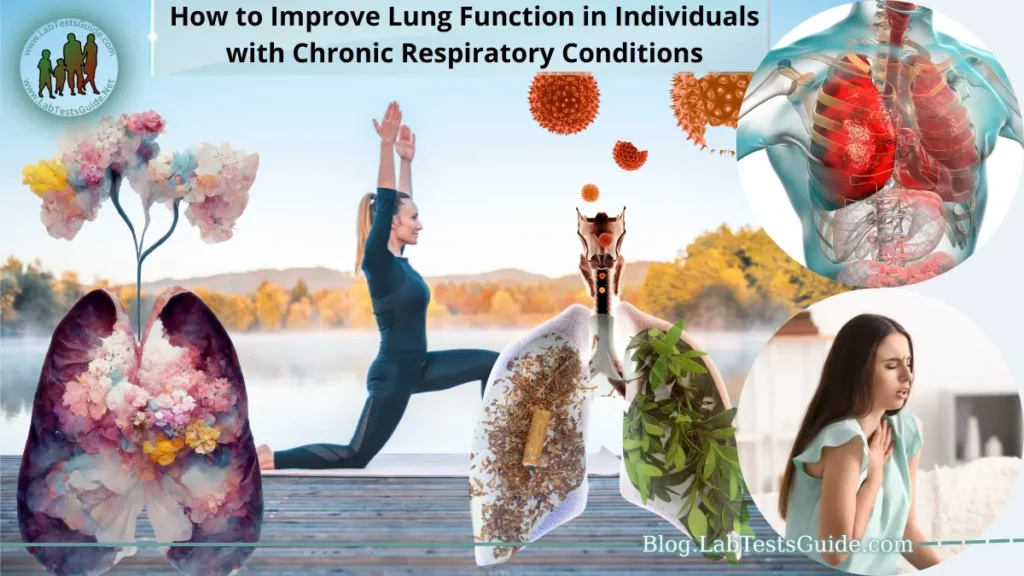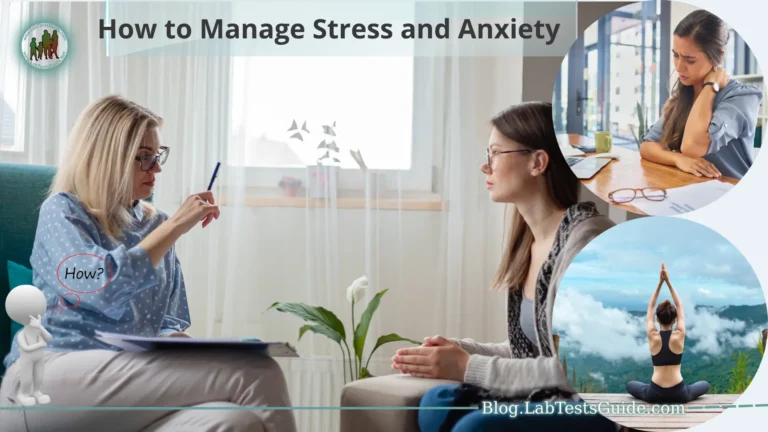Chronic respiratory conditions, such as asthma, COPD, bronchiectasis, and cystic fibrosis, pose significant challenges to individuals, affecting their lung function and overall well-being. These conditions are characterized by chronic inflammation, airway narrowing, and decreased lung capacity. Maintaining optimal lung function is crucial for daily activities and overall health.

This guide aims to provide practical strategies and recommendations to help individuals with chronic respiratory conditions improve their lung function and manage their symptoms effectively. However, it is important to note that personalized advice and treatment plans from healthcare providers are essential, as they can tailor the recommendations to each individual’s specific condition and needs. By following the strategies outlined in this guide and seeking professional guidance, individuals can take proactive steps toward enhancing their lung function and ultimately improving their quality of life.
Importance of Improving Lung Function:
The following points.
- Enhanced Oxygen Supply: Emphasize that the lungs play a critical role in oxygenating the blood and delivering it to various organs and tissues. Improved lung function ensures an adequate supply of oxygen, which is essential for energy production and overall bodily functions.
- Reduced Respiratory Symptoms: Discuss how improving lung function can help alleviate common respiratory symptoms such as shortness of breath, wheezing, coughing, and chest tightness. Enhanced lung capacity and airflow can lead to better respiratory control and a reduced frequency and severity of symptoms.
- Improved Physical Activity and Fitness: Explain that optimal lung function allows individuals to engage in physical activities with greater ease and endurance. By improving lung function, individuals can enhance their exercise capacity, increase their overall fitness levels, and enjoy a more active lifestyle.
- Prevention of Complications: Highlight that maintaining good lung function can help prevent or minimize complications associated with chronic respiratory conditions. These complications may include respiratory infections, exacerbations of symptoms, and the progression of the underlying condition.
- Quality of Life: Emphasize that better lung function translates into an improved quality of life. With improved respiratory function, individuals can participate more fully in daily activities, enjoy social interactions, and pursue hobbies and interests without being limited by their respiratory condition.
By underscoring the importance of improving lung function, individuals are motivated to take proactive steps toward enhancing their respiratory health and implementing the strategies discussed in the subsequent sections of the guide.
Medications for Chronic Respiratory Conditions:
The following subsections.
Bronchodilators:
- Explain that bronchodilators are medications that help relax and widen the airways, making it easier to breathe.
- Differentiate between short-acting bronchodilators, such as beta-agonists (e.g., albuterol), used for immediate relief of symptoms, and long-acting bronchodilators used for long-term management.
- Discuss how bronchodilators can be administered through inhalers or nebulizers and the importance of proper inhalation techniques.
Corticosteroids:
- Describe corticosteroids as anti-inflammatory medications that help reduce airway inflammation.
- Explain that corticosteroids can be inhaled (inhaled corticosteroids) or taken orally (systemic corticosteroids) depending on the severity of the condition.
- Highlight the importance of consistent use of inhaled corticosteroids for long-term control of chronic respiratory conditions.
Antibiotics (if necessary):
- Mention that antibiotics may be prescribed for individuals with chronic respiratory conditions who develop respiratory infections caused by bacteria.
- Explain that antibiotics help treat the underlying infection and prevent further complications.
- Note that antibiotics should be used as directed by a healthcare provider and only when necessary to avoid antibiotic resistance.
Combination Medications:
- Discuss combination medications that contain both bronchodilators and corticosteroids in a single inhaler.
- Explain that combination medications offer the benefits of both medications, simplifying the treatment regimen and improving medication adherence.
Importance of Adherence:
- Emphasize the importance of adhering to prescribed medication regimens and following healthcare provider instructions.
- Highlight that consistent use of medications is crucial for long-term management and improvement of lung function.
Smoking Cessation:
The section on smoking cessation focuses on the importance of quitting smoking for individuals with chronic respiratory conditions. It provides information and strategies to help individuals successfully quit smoking. It may include the following subsections.
Effects of Smoking on Lung Function:
- Explain the detrimental effects of smoking on lung health, including lung inflammation, airway narrowing, and increased mucus production.
- Highlight that smoking exacerbates respiratory symptoms and accelerates the progression of chronic respiratory conditions.
- Emphasize the importance of quitting smoking to preserve and improve lung function.
Benefits of Quitting Smoking:
- Discuss the numerous benefits of quitting smoking, such as improved lung function, reduced respiratory symptoms, decreased risk of respiratory infections, and slower disease progression.
- Mention other positive effects, including improved cardiovascular health, reduced risk of cancer, and better overall well-being.
Strategies to Quit Smoking:
- Provide practical strategies and techniques to help individuals quit smoking, such as setting a quit date, seeking support from healthcare professionals, and involving family and friends for support.
- Discuss the use of nicotine replacement therapy (NRT), such as nicotine patches, gum, or inhalers, as a way to manage nicotine cravings.
- Mention other smoking cessation aids, such as prescription medications (e.g., bupropion, varenicline), behavioral counseling, and support groups.
Lifestyle Changes and Coping Strategies:
- Encourage individuals to adopt healthy lifestyle changes, including regular exercise, stress reduction techniques, and a balanced diet, to support the quitting process.
- Suggest coping strategies to manage cravings and withdrawal symptoms, such as engaging in activities to distract from smoking urges, practicing deep breathing exercises, or using alternative oral substitutes (e.g., sugar-free gum or mints).
Relapse Prevention:
- Discuss the importance of developing strategies to prevent relapse, such as identifying triggers, avoiding situations associated with smoking, and seeking ongoing support from healthcare providers and support groups.
Pulmonary Rehabilitation:
The section on pulmonary rehabilitation focuses on the importance and benefits of participating in a pulmonary rehabilitation program for individuals with chronic respiratory conditions. It may include the following subsections.
Purpose and Benefits of Pulmonary Rehabilitation:
- Explain that pulmonary rehabilitation is a comprehensive program designed to improve the overall well-being of individuals with chronic respiratory conditions.
- Discuss the main goals of pulmonary rehabilitation, which include improving lung function, reducing symptoms, enhancing exercise tolerance, and promoting self-management skills.
- Highlight the potential benefits of pulmonary rehabilitation, such as increased respiratory muscle strength, improved quality of life, better symptom control, and decreased healthcare utilization.
Components of Pulmonary Rehabilitation Programs:
- Describe the various components typically included in pulmonary rehabilitation programs, such as exercise training, education, breathing techniques, and psychosocial support.
- Explain that exercise training is a core component and may involve aerobic exercises, strength training, and flexibility exercises tailored to each individual’s capabilities and needs.
- Discuss the importance of education in pulmonary rehabilitation, including topics like proper medication use, energy conservation techniques, symptom management, and nutritional guidance.
- Mention the inclusion of breathing techniques, such as pursed-lip breathing and diaphragmatic breathing, to improve breathing efficiency and control.
- Highlight the value of psychosocial support, which may involve counseling, support groups, and strategies to manage anxiety and stress related to chronic respiratory conditions.
Program Duration and Setting:
- Explain that pulmonary rehabilitation programs can vary in duration, typically lasting several weeks to a few months, depending on the individual’s needs and program structure.
- Mention that pulmonary rehabilitation can be conducted in various settings, including hospitals, outpatient clinics, or home-based programs, depending on availability and individual circumstances.
Benefits of Supervised Exercise:
- Discuss the advantages of supervised exercise in pulmonary rehabilitation programs, which provide guidance, monitoring, and appropriate progression of exercise routines.
- Emphasize that supervised exercise sessions allow healthcare professionals to ensure safety, proper technique, and individualized exercise prescription.
Physical Activity and Exercise:
The section on physical activity and exercise focuses on the role of regular physical activity in improving lung function and managing chronic respiratory conditions. It may include the following subsections.
Importance of Physical Activity for Lung Function:
- Explain the benefits of regular physical activity in enhancing lung function, such as improving oxygen delivery, strengthening respiratory muscles, and increasing lung capacity.
- Highlight that physical activity helps maintain overall fitness, reduces breathlessness, and improves cardiovascular health.
Suitable Exercises for Individuals with Chronic Respiratory Conditions:
- Discuss low-impact exercises that are generally well-tolerated by individuals with chronic respiratory conditions, such as walking, swimming, cycling, and gentle aerobics.
- Mention that these exercises can be adapted to individual abilities and preferences, and that a healthcare provider’s guidance is crucial to determine appropriate exercise intensity and duration.
Warm-up and Cool-down:
- Emphasize the importance of warm-up and cool-down exercises before and after physical activity sessions.
- Explain that warm-up exercises prepare the body for activity by increasing blood flow and loosening muscles, while cool-down exercises help gradually lower heart rate and prevent muscle soreness.
Monitoring Exercise Intensity:
- Discuss methods to monitor exercise intensity, such as using the Borg Rating of Perceived Exertion (RPE) scale or heart rate monitoring.
- Explain the importance of exercising within a comfortable range, avoiding excessive strain, and adjusting intensity based on individual tolerance.
Safety Considerations:
- Highlight the importance of consulting with a healthcare provider before starting or modifying an exercise program.
- Discuss safety considerations, such as exercising in well-ventilated areas, avoiding extreme weather conditions, and having a rescue inhaler readily available for individuals with asthma.
Breathing Exercises and Techniques:
The section on breathing exercises and techniques focuses on various breathing techniques that can improve lung function, enhance respiratory control, and manage symptoms in individuals with chronic respiratory conditions. It may include the following subsections.
Pursed-Lip Breathing:
- Explain pursed-lip breathing as a technique that involves inhaling slowly through the nose and exhaling gently through pursed lips, as if blowing out a candle.
- Describe how pursed-lip breathing helps control the pace of breathing, promotes better airflow, and reduces breathlessness by slowing down the exhalation process.
- Provide instructions on how to perform pursed-lip breathing correctly, emphasizing relaxation and the use of the diaphragm.
Diaphragmatic Breathing:
- Introduce diaphragmatic breathing, also known as belly breathing or deep breathing, which involves using the diaphragm muscle to take deep breaths.
- Explain that diaphragmatic breathing helps optimize lung capacity, improves oxygenation, and reduces shallow breathing patterns.
- Provide step-by-step instructions on diaphragmatic breathing, including placing a hand on the abdomen to feel it rise and fall with each breath.
Other Breathing Techniques:
- Discuss additional breathing techniques that individuals with chronic respiratory conditions may find beneficial, such as.
- Segmental breathing: Focusing on specific areas of the lungs while breathing deeply.
- Controlled breathing: Regulating the length and pace of inhalation and exhalation to promote relaxation.
- Alternate nostril breathing: Using finger pressure to alternate breathing through each nostril, which can help balance airflow and calm the mind.
Integration into Daily Life:
- Emphasize the importance of practicing breathing exercises regularly to improve respiratory muscle strength and promote efficient breathing patterns.
- Suggest integrating breathing exercises into daily activities, such as performing them before or after physical activity, during periods of stress, or as a part of a relaxation routine.
Professional Guidance and Support:
- Mention that individuals should initially learn breathing techniques under the guidance of a healthcare professional, such as a respiratory therapist or physiotherapist.
- Highlight the potential benefits of attending specialized breathing or pulmonary rehabilitation programs that provide education and training in breathing techniques.
Nutritional Considerations:
The section on nutritional considerations focuses on the importance of proper nutrition in improving lung function and managing chronic respiratory conditions. It may include the following subsections.
Importance of Nutrition for Respiratory Health:
- Explain that adequate nutrition is essential for maintaining overall health and supporting lung function.
- Discuss how a well-balanced diet can help strengthen the immune system, reduce inflammation, and provide the necessary nutrients for optimal lung health.
Recommended Diet for Improving Lung Function:
- Emphasize the importance of consuming a varied and nutrient-rich diet.
- Encourage individuals to include a variety of fruits, vegetables, whole grains, lean proteins, and healthy fats in their meals.
- Discuss the benefits of specific nutrients for lung health, such as antioxidants (found in colorful fruits and vegetables) and omega-3 fatty acids (found in fatty fish, flaxseeds, and walnuts).
Hydration:
- Highlight the importance of staying hydrated to maintain healthy lung function.
- Encourage individuals to drink an adequate amount of water throughout the day to keep respiratory passages moist and support mucus clearance.
Weight Management:
- Discuss the importance of maintaining a healthy weight, as excess weight can place additional strain on the respiratory system.
- Encourage individuals to work with a healthcare professional or registered dietitian to develop a personalized weight management plan if needed.
Avoiding Trigger Foods:
- Suggest identifying and avoiding foods that may trigger respiratory symptoms or allergies, as these can vary from person to person.
- Discuss common trigger foods like dairy products, processed foods, and foods high in sodium.
Eating Patterns and Meal Size:
- Provide guidance on eating smaller, more frequent meals to prevent overeating and reduce the feeling of breathlessness.
- Encourage individuals to practice mindful eating and pay attention to portion sizes.
What is Environmental Modifications:
Environmental modifications refer to changes made to the living environment to improve respiratory health and reduce exposure to triggers or pollutants that may exacerbate chronic respiratory conditions. It involves identifying and addressing factors in the physical environment that can negatively impact lung function and respiratory symptoms. Some common aspects of environmental modifications include.
Indoor Air Quality:
- Focuses on improving the quality of air indoors, as individuals with chronic respiratory conditions spend a significant amount of time indoors.
- Involves minimizing exposure to indoor pollutants such as tobacco smoke, dust, pet dander, mold, and volatile organic compounds (VOCs).
- Recommendations may include proper ventilation, use of air purifiers or filters, regular cleaning, and reducing or eliminating smoking indoors.
Allergen Control:
- Aims to reduce exposure to allergens that can trigger respiratory symptoms in individuals with allergies or asthma.
- Involves strategies like regular cleaning to reduce dust mites, using hypoallergenic bedding and pillow covers, minimizing exposure to pet dander, and implementing proper pest control measures.
Mold and Moisture Prevention:
- Targets the prevention and remediation of mold growth, which can worsen respiratory symptoms and contribute to allergies.
- Involves fixing leaks and addressing moisture issues promptly, ensuring proper ventilation, and using dehumidifiers in damp areas.
Pollutant Reduction:
- Focuses on minimizing exposure to outdoor air pollutants, such as vehicle emissions, industrial pollutants, and outdoor allergens.
- Strategies may include avoiding outdoor activities during high pollution or allergen days, using air purifiers at home, and keeping windows closed during peak pollution times.
Occupational Exposures:
- Addresses potential workplace hazards or exposures that may negatively impact respiratory health.
- Involves working with occupational health professionals to assess and mitigate risks, such as using appropriate protective equipment and implementing proper ventilation systems.
How to Manage Stress and Anxiety:
Here are some strategies to effectively manage stress and anxiety.
Relaxation Techniques:
- Practice relaxation techniques such as deep breathing exercises, progressive muscle relaxation, or guided imagery.
- Engage in activities that promote relaxation, such as meditation, yoga, or tai chi.
Cognitive-Behavioral Techniques:
- Utilize cognitive-behavioral techniques to challenge negative thoughts and reframe them in a more positive and realistic way.
- Engage in activities that promote positive thinking, self-care, and self-compassion.
Stress Reduction Activities:
- Engage in activities that help reduce stress, such as listening to calming music, reading, taking a warm bath, or spending time in nature.
- Find hobbies or activities that bring joy and relaxation, such as painting, gardening, or listening to podcasts.
Social Support:
- Seek support from family, friends, or support groups to share experiences, feelings, and concerns.
- Engage in social activities or hobbies that provide a sense of connection and support.
Time Management:
- Prioritize tasks and responsibilities to manage time effectively and reduce feelings of overwhelm.
- Break tasks into smaller, manageable steps and set realistic goals.
Healthy Lifestyle:
- Maintain a healthy lifestyle with regular exercise, balanced nutrition, and adequate sleep.
- Engage in regular physical activity, as exercise helps reduce stress and anxiety.
Seek Professional Help:
- Consider seeking professional help from mental health professionals, such as therapists or counselors, who can provide guidance and support in managing stress and anxiety.
- Explore therapy options such as cognitive-behavioral therapy (CBT) or mindfulness-based stress reduction (MBSR) programs.
FAQs:
How long does it take to see improvements in lung function with medication and lifestyle changes?
The timeframe for improvements in lung function can vary depending on the individual, the specific respiratory condition, and the interventions implemented. Generally, consistent medication use and lifestyle changes can lead to noticeable improvements within a few weeks to a few months. However, it is important to continue with prescribed treatments and maintain healthy habits in the long term for sustained benefits.
Can I exercise if I have a chronic respiratory condition?
Yes, exercise is generally encouraged for individuals with chronic respiratory conditions. However, it is important to consult with a healthcare provider to determine the most suitable exercises and intensity levels based on individual capabilities and condition severity. Low-impact activities like walking, swimming, and cycling are often well-tolerated and can help improve lung function and overall fitness.
Are breathing exercises helpful for managing respiratory symptoms?
Yes, breathing exercises can be beneficial for individuals with chronic respiratory conditions. Techniques such as pursed-lip breathing and diaphragmatic breathing can help improve breathing control, reduce breathlessness, and enhance oxygenation. They can be incorporated into daily routines and used during times of symptom exacerbation or stress. It is recommended to learn these techniques under the guidance of a healthcare professional.
How effective is pulmonary rehabilitation in improving lung function?
Pulmonary rehabilitation programs have shown to be effective in improving lung function, reducing symptoms, and enhancing quality of life for individuals with chronic respiratory conditions. These programs typically involve a combination of exercise training, education, breathing techniques, and psychosocial support. Consistent participation and adherence to the program can lead to significant improvements in lung function and overall respiratory health.
Does quitting smoking really improve lung function?
Yes, quitting smoking is one of the most important steps individuals can take to improve lung function. Smoking damages the lungs and exacerbates respiratory conditions. When individuals quit smoking, their lungs begin to heal, and lung function can improve over time. It is never too late to quit smoking, and even individuals with long-term smoking histories can experience significant benefits from quitting.
Can medications alone improve lung function, or do I need to make lifestyle changes as well?
Medications play a crucial role in managing chronic respiratory conditions and improving lung function. They help reduce inflammation, relax airway muscles, and treat infections. However, lifestyle changes such as quitting smoking, engaging in regular physical activity, practicing breathing exercises, and maintaining a healthy diet are equally important. A combination of medications and lifestyle changes tends to yield the best results in improving lung function and overall respiratory health.
Conclusion:
In conclusion, improving lung function in individuals with chronic respiratory conditions is a key goal for enhancing their overall health and well-being. Through a combination of medications, lifestyle changes, and supportive strategies, individuals can take proactive steps towards managing their respiratory conditions and improving their lung function.






